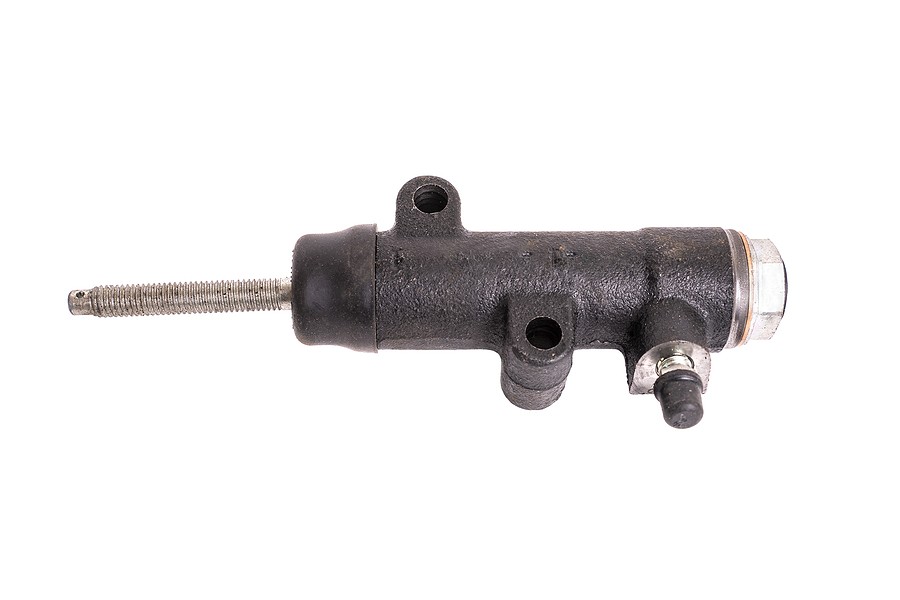The master cylinder is a key part of your braking system, ensuring that your car stops quickly and when you want it to. When you press down on the brake pedal and apply force to the brake, the braking system of the car uses a brake master cylinder in order to convert the mechanical pressure you place on the pedal into hydraulic pressure to stop the vehicle.
The conversion of pressure between the mechanical and physical pressure into the hydraulic pressure takes place since the brake master cylinder transfers the brake fluid to the braking system in the car as you step and provide force with one brake pedal.
The brake master cylinder will do this even if your car is using disc brakes or drum brakes in your car. There is no way that any other braking system could exist without the use of a brake master cylinder. This shows why the brake master cylinder cost is so important and the factors that can influence the master cylinder cost in your car.
Bad brake master cylinder symptoms
Once the brake master cylinder starts to go bad, you need to know the total master cylinder cost. If you notice the brake master cylinder is showing signs of wear and tear and damage, there will be certain noticeable symptoms that will come up. If you suspect an issue with your brake master cylinder due other symptoms you are noticing, you should address the problem almost immediately to prevent any further issues.
It is very dangerous to drive without brakes that work properly, since this can increase the risk of a crash and cause you to not be able to stop the car when needed. We have gone over the top symptoms of a bad brake master cylinder that you will notice and that can enhance the master cylinder cost.
Warning light
The first main symptom that can influence the master cylinder cost and the easiest to notice sign is that the brake warning light illuminates on the dashboard and alerts the driver to problems. This indicates that there is some kind of problem within the braking system, whether it be with the brake pedals or brake pads, but might not necessarily indicate there is a direct issue with the brake master cylinder directly.
However, if the braking system sensors detect that the brake fluid pressure is dropping significantly during use, it will more often than not be due to a bad brake master cylinder, which can result in the warning light coming on and enhancing the master cylinder cost. If the ABS light comes on, the main cause tand the root issue could be the brake master cylinder, especially if the master cylinder is leaking brake fluid into the system.
Brake fluid leak
The brake master cylinder needs a certain level of brake fluid in order to maintain the hydraulic pressure that is required to slow down the vehicle when you want it to send when you need to to stop on the road. If the brake master cylinder is leaking brake fluid, or if the reservoirs are unsecured and holding too much brake fluid in the car, then you will be guaranteed of having a low brake fluid level and increasing the total master cylinder cost.
If you have a brake fluid leak and you do not have enough fluid to stop your car properly, then this can impair the ability to slow down the vehicle and stop the car. You would need to replace the brake master cylinder in this situation which increases the master cylinder cost.
Spongy brake pedal
When the brake pedal feels spongy and if you feel that you are having a soft brake pedal as you press on the pedal with your foot to stop the car, this will be a sure sign and symptom that your brake master cylinder is having problems and can be damaged over time. If the soft brake pedal has issues, this is a sign that you have a higher master cylinder cost for replacement.
The cylinder contains rubber seals that keep the brake fluid inside of it. If these rubber seals were getting worn down over time, became damaged, or have succumbed to wear and tear, then there would be an internal brake fluid leak that can cause a higher master cylinder cost. The result of this would be a spongy feeling in the brake pedal which can make it difficult to stop.
Contaminated brake fluid
Another issue that can happen as a result of the worn out rubber seals is the contamination of the brake fluid. If you have contaminated brake fluid, the fuel filter can get clogged and cause issues. The seals not only help keep the brake fluid from coming out, but they also prevent dirt, debris, and other contaminants from mixing with the brake fluid and causing a higher master cylinder cost.
If this were going to happen in your car, the brake pressure would not be as strong as if you step on the brake pedal to stop your car and slow down the vehicle. This can result in your pressing down harder on the pedal to get the vehicle to slow down like normal, requiring more physical pressure on the brake pedal and causing a higher master cylinder cost for a repair or replacement.
Sinking brake pedal
Along with all of these other symptoms, you will start noticing the brake pedal not springing back up to the top after you have removed your foot from the brake pedal, and cause the brake pedal to sink slowly to the floor and make it hard to repress the brakes when needed. This can become a real driving hazard, since you cannot press the brake multiple times to stop the car. This is a real sign that you need to fix the master cylinder right away and cause a higher master cylinder cost.
Bad brake bias
Brake master cylinders usually have two different circuits that are used to separate brake fluid to the wheels in two different pairs, to the front and the rear wheels. This is to prevent a complete loss of braking in the occasion that there is a leak on one side of the braking system. More often than not these brake circuits will control one front wheel and the opposite rear wheel.
This is to prevent a complete failure if one circuit has failed. If one circuit has failed, you might notice the car pulling to one side when you're braking. This will be most
apparent when you press down on the brakes really hard, as the front brakes have more power of stopping than the rear brakes. By preventing a complete failure, this can keep the master cylinder cost replacement form being too high.
Uneven brake pad wear
If only two out of four wheels can apply the brakes to stop the car, you will notice that there is uneven brake pad wear in your car. For instance, the car might pull to one side and cause uneven brake pad wear that can harm your car and your braking system.
A failure of multiple or just one of the pistons seals in the master cylinder or the brake line leak can cause one circuit to fail. If you notice that your car has uneven braking, or uneven pad wear, then the brake master cylinder could be the reason, which can increase the overall master cylinder cost.
Master cylinder Replacement cost
If you have a brake master cylinder that goes bad, this can cause the master cylinder cost to be higher. The average cost to replace the master cylinder will be around $320 and $500, with the parts cost being between $100 and $210, and the labor costs to be between $230 and $300 on average.
If you have an idea of how to do this yourself, then you can save the money on the labor costs by doing this yourself.
However, it is a key job that requires you to have a good amount of car repair experience to prevent making anything else worse in your vehicle. You can figure out how to replace the master cylinder and reduce the master cylinder cost by unbolting the master cylinder from the firewall, disconnecting the brake lines, and reinstalling the new unit.
Sample Brake Master Cylinder Replacement Cost
In order to figure out how much you might spend for a replacement of your master cylinder cost, we have laid out some average prices for various types of cars that you will commonly find.
First, one of the least expensive cars for the master cylinder cost is the 2008 Ford Explorer, costing around $256 for the master cylinder replacement, with the parts cost coming out to around $127 and the labor cost coming out to the same amount. The next least expensive option is the 2012 Chevrolet Orlando, with the total cost coming out to around $301, with the parts being around $197 and the labor being around $103.
The middle of the road options in terms of pricing involve the 2009 Kia Rondo and the 2005 BMW 545i. The Kia Rondo comes out to around $452, with the parts cost coming out to around $347 and the labor being around $103. The BMW 545i has a parts cost of $#60, while the labor cost is around $127.
The most expensive options for the master cylinder cost feature the 2009 Jaguar Vanden Plas and the 2012 BMW 550i xDrive. The 2009 Jaguar has a total cost of around $509, with the parts cost coming out to $308 and the labor coming out to nearly $200. The total BMW price comes out to around $578, with the parts cost coming out to $450 and the labor being around $127.
How to replace the master cylinder
Mechanics are usually in charge of replacing the brake master cylinders, but if you feel like you can do it on your own, you should know the steps to take in order to reduce the overall master cylinder cost.
First, on vehicles with power brakes, the master cylinder is bolted to the metal housing of the power brake booster. In most cars, there is usually an electrical plug connecting to a brake fluid level sensor on the master cylinder reservoir and that plug needs to be disconnected.
Second, once all steel brake lines are disconnected and not attached to the master cylinder is unbolted from the brake booster and taken out of the vehicle. After this has been done, the new master cylinder must be bled to get out the air from the internal passages that contain the piston. After this, the new master cylinder is bolted to the brake booster and the brake lines are reattached. The electrical plug for the fluid level sensor is reconnected.
When the new master cylinder is installed in the car, brake lines to wheel positions must be bled to remove the air, contaminated fluid, and the old fuel. If your vehicle is equipped with anti lock brakes, the mechanic might use a scan tool in order to actuate the ABS pump during the brake bleeding, making sure that all of the air is removed from the valving of the ABS system.
Lastly, the brake line connections that were removed during the master cylinder replacement are inspected and checked for any leakage and the vehicle is tested on the road to ensure normal operation of the brakes.
Keep in mind when replacing the master cylinder that it is only one component of many in a vehicle's braking system, meaning that all braking system parts should be inspected to ensure that the brakes are working correctly and you have maximum braking power.
In addition, the amount of friction material remaining on the brake pads and shoes need to be verified, along with the brake lines and rubber hoses being inspected for any corrosion or deterioration.



